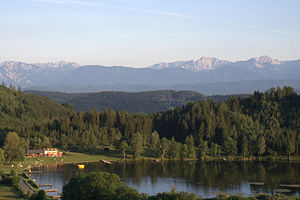St. Urban Lake
| St. Urban Lake | ||
|---|---|---|

|
||
| View towards the north bank | ||
| Geographical location | southwest of Sankt Urban , Feldkirchen District , Carinthia , Austria | |
| Drain | Liembergbach → Feistritz → Glan | |
| Location close to the shore | Bach, Retschitz, Gasmai, Sankt Urban (Carinthia) | |
| Data | ||
| Coordinates | 46 ° 44 '44 " N , 14 ° 9' 44" E | |
|
|
||
| Altitude above sea level | 745 m above sea level A. | |
| surface | 9 ha | |
| volume | 150,000 m³ | |
| Maximum depth | 3 m | |
| Middle deep | 1.7 m | |

|
||
| Lido at Urbansee | ||
The St. Urbaner See is an artificially created small lake northeast of Feldkirchen in Carinthia . It is located in a side valley of the Glan in the Sörger Mountains. It is part of the nature reserve of the same name .
Despite its altitude, the lake is warm in summer and is therefore a popular bathing water . In 2009 the lake was classified as mesotrophic and the hygienic condition was very good.
geography
The lake is 745 m above sea level. A. and covers an area of about nine hectares . It was artificially dammed by building an approximately 200 m long dam on the east side of the current lake. In the dam area it also has its greatest depth of around three meters. In the west the lake is getting shallower. Here it turns into swampy terrain, in which there are two small lakes with an area of around one and a half hectares. The small tributary that flows through the two lakes before it flows into the St. Urbaner See is also located in this area.
ecology
A good part of the lake is covered with underwater and floating leaf plants as well as reeds . The dominant species are milfoil and floating pondweed . In the silting area , rushes , sedge species , tortoiseshell and fever clover occur. In the water close to the bank, species of water hose , mermaid and, in some places, candelabrum algae grow . The inland moor areas have the lung gentian and tongue buttercup as special features .
The lake is drained regularly, which leads to a depletion of the fish population and subsequent recovery. In the past, perch , roach and rudd dominated . At the end of winter 1996, due to the long ice cover and the subsequent oxygen consumption, fish died off , to which around 1400 kg of biomass fell victim, as well as around 400 noble crabs ( Astacus astacus ). After the next stocking with 100 kg of pike, the lack of feed fish led to a spotted disease and half the population died.
Landscape protection area
The St. Urbaner See was declared a landscape protection area of St. Urbaner See in 1970 with the cultivated areas in the north and the St. Urbaner Berg (LGBl. No. 31/1970), the entire area covers 140 hectares.
See also
supporting documents
- Helmut Hartl, Hans Sampl, Ralf Unkart: Carinthia's gems. National parks, nature reserves, landscape reserves, natural monuments . Kärntner Druck- und Verlagsgesellschaft, Klagenfurt 1993, ISBN 3-85391-092-0 , p. 110.
Individual evidence
- ↑ Lake Report 2010 , accessed on February 6, 2011.
- ↑ St. Urbaner See on the website of the Carinthian Institute for Lake Research , accessed February 6, 2011.
Web links
- St. Urbaner See on the website of the Carinthian Institute for Lake Research

